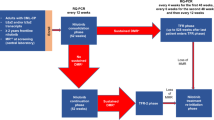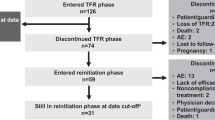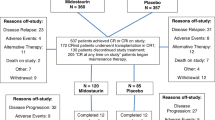Abstract
The prognosis for patients with acute myeloid leukemia in first relapse is generally poor. The ability to induce a second complete remission (CR) with the same chemotherapy used in initial induction therapy is limited. Remission inversion rate, defined as achieving a longer second CR than the first CR in response to standard chemotherapy for relapse, is important in assessing studies of novel chemotherapy or immunologic treatment strategies for patients with relapsed disease. One hundred and twenty-four patients entered on two Eastern Cooperative Oncology Group (ECOG) studies for patients with relapsed AML were analyzed to determine the remission inversion rate. Twenty-two of the 124 patients (18%; 95% confidence interval 12–26%) experienced a longer second CR duration than the first CR duration by at least 2 months. Inversion of CR duration is thus not a rare event. The inversion frequency reported here establishes a baseline upon which future studies in relapsed disease need to be defined.
This is a preview of subscription content, access via your institution
Access options
Subscribe to this journal
Receive 12 print issues and online access
$259.00 per year
only $21.58 per issue
Buy this article
- Purchase on Springer Link
- Instant access to full article PDF
Prices may be subject to local taxes which are calculated during checkout
Similar content being viewed by others
References
Yates JW, Glidwell O, Wiernik PH, Cooper MR, Steinberg D, Desik H, Levy R, Hoogland C, Henry P, Gottleib A, Cornell C, Berenberg J, Hutchinson JL, Raich P, Nissen N, Ellison RR, Frelick R, James GW, Falkson G, Silver RT, Haurani F, Green M, Hendersen E, Leone L, Holland JF . Cytosine arabinoside with daunorubicin or adriamycin for therapy of acute myelocytic leukemia: a CALGB study Blood 1982 60: 454–462
Tallman MS, Appelbaum FR, Amos D, Goldberg RS, Livingston RB, Mortimer J, Weiden PL, Thomas ED . Evaluation of intensive consolidation therapy or adults with acute nonlymphocytic leukemia using high-dose cytosine arabinoside with asparaginase and amsacrine with etoposide J Clin Oncol 1987 55: 918–926
Wiernik PH, Banks PLC, Case DC, Arlin ZA, Periman PO, Todd MB, Ritch PS, Enck RE, Wortberg AB . Cytarabine plus idarubicin or daunorubicin as induction and consolidation therapy for previously untreated adult patients with acute myeloid leukemia Blood 1992 79: 313–319
Mayer RJ, Davis RB, Schiffer CA, Berg DT, Powell BL, Schulman P, Omura GA, Moore JO, McIntyre OR, Frei E . Intensive postremission chemotherapy in adults with acute myeloid leukemia New Engl J Med 1994 331: 896–903
Rowe JM, Andersen JW, Mazza JJ, Bennett JM, Paietta E, Hayes FA, Oette D, Cassileth Pa, Stadtmauer EA, Wiernik PH . A randomized placebo-controlled phase III study of granulocyte-macrophagecolony-stimulating factor in adult patients (>55 to 70 years of age) with acute myelogenous leukemia: a study of the Eastern Cooperative Oncology Group (E1490) Blood 1995 86: 457–462
Peterson BA, Bloomfield CD . Long-term disease-free survival in acute nonlymphocytic leukemia Blood 1981 57: 1144–1147
Zittoun R, Jehn U, Fiere D, Haanen C, Lowenberg B, Willemze R, Abels J, Bury J, Peetermans M, Hayat M, Suici S, Salbu G, Stryckmans P . Alternating vs repeated postremission treatment in adult acute myelogenous leukemia: a randomized phase III study (AMLb) of the EORTC Leukemia Cooperative Group Blood 1989 73: 896–906
Phillips GL, Reece DE, Shepherd JL, Barnett MJ, Brown RA, Frei-Lahr DA, Klingemann HG, Bolwell BJ, Spirelli JJ, Herzig RH, Herzig GP . High-dose cytarabine and daunorubicin induction and postremission chemotherapy for the treatment of acute myelogenous leukemia in adults Blood 1991 77: 1429–1435
Bennett JM, Andersen JW, Cassileth PA . Long-term survival in acute myeloid leukemia: the Eastern Cooperative Oncology Group experience Leukemia Res 1991 15: 223–227
Smits P, Schoots L, de Pauw BE et al. Prognostic factors in adult patients with acute leukemia at first relapse Cancer 1987 59: 1631–1634
Archimbaud E, Leblond V, Michallet M et al. Intensive sequential chemotherapy with mitoxantrone and continuous infusion etoposide and cytarabine for previously treated acute myelogenous leukemia Blood 1991 77: 1894–1900
Amadori S, Arcese W, Isacchi G, Melomi G, Petti MC, Monarca B, Testi AM, Mandelli F . Mitoxantrone, etoposide, and intermediate dose cytarabine: an effective and tolerable regimen for the treatment of refractory acute myeloid leukemia J Clin Oncol 1991 9: 1210–1214
Sato H, Dreisler H, Day R, Raza A, Larson R, Brownman G, Goldberg J, Volger R, Grunwald H, Gottlieb A . MDR transcript levels as an indication of resistant disease in acute myelogenous leukemia Br J Haematol 1990 75: 340–345
Kantarjian HM, Keating MJ, Walters RS, McCredie KB, Freireich EJ . The characteristics and outcome of patients with late relapse acute myelogenous leukemia J Clin Oncol 1988 6: 232–238
Davis CL, Rohatiner AZS, Lim J, Whelan JS, Oza AM, Amess J, Love S, Stead E, Lister TA . The management of recurrent acute myelogenous leukemia at a single center over a fifteen year period Br J Haematol 1993 83: 404–411
Keating MJ, Kantarjian H, Smith TL, Estey E, Walters R, Andersson B, Beran M, McCredie KB, Freireich EJ . Response to salvage therapy and survival after relapse in acute myelogenous leukemia J Clin Oncol 1989 7: 1071–1080
Hiddemann W, Martin WR, Saverland CM, Heinecke A, Buchner T . Definition of refractoriness against conventional chemotherapy in acute myeloid leukemia: a proposal based on the results of retreatment by thioguanine, cytosine arabinoside and daunorubicin (TAD9) in 150 patients with relapse after standardized first line therapy Leukemia 1990 4: 184–188
Letendre L, Kiely JM, Hogland HC . Reinduction chemotherapy for acute nonlymphocytic leukemia Mayo Clin Proc 1984 59: 618–621
Estey E . Treatment of refractory AML Leukemia 1996 10: 932–936
Uhlinan DL, Bloomfield CD, Hurd DD, Peterson BA . Prognostic factors at relapse for adults with acute myeloid leukemia Am J Hematol 1990 33: 110–116
Oken MM, Kim K, Mazza JJ, Hines JD, Bennett JM, Cassileth PA, O'Connell MJ . Maintenance low-dose Ara-C (LDAC) improves complete remission (CR) duration from salvage induction therapy for relapsed and refractory acute myeloid leukemia (AML) Proc Am Soc Clin Oncol 1991 78: (Suppl.) 10 (Abstr.)
Rowe JM, Andersen JW, Mazza JJ et al. Treatment of relapsed and refractory AML with mitoxantrone and etoposide: a study of the ECOG. In: Buchner T et al (eds) Acute Leukemia IV Springer-Verlag: Berlin 1994 pp 235–238
Kaplan EL, Meier P . Nonparametric estimation from incomplete observations J Am Stat Assoc 1958 53: 547–581
Greenwood M . A report on the natural duration of cancer. Reports on Public Health and Medical Subjects HM Stationery Office: London 1926 33: pp 1–26
Cox DR, Snell EJ . The analysis of binary data Chapman and Hall: New York 1989
Higuchi C, Thompson J, Petersen F et al. Toxicity and immunomodulatory effects of interleukin-2 after autologous bone marrow transplantation for hematologic malignancies Blood 1991 77: 2561–2568
Robinson N, Benyunes MC, Thompson JA, York A, Petersdorf S, Press O, Lindgren C, Chauncey T, Buckner DC, Bensigner WI, Appelbaum FR, Fefer A . Interleukin-2 after autologous stem cell transplantation for hematologic malignancy: a phase I/II study Bone Marrow Transplant 1997 19: 435–442
Robinson N, Sanders, JE, Benyunes MC, Beach K, Lindgren C, Thompson JA, Appelbaum FR, Fefer A . Phase I trial of interleukin-2 after unmodified HLA-matched sibling bone marrow transplantation for children with acute leukemia Blood 1996 87: 1249–1254
Wiernik PH, Dutcher JP, Todd M, Duffy T, Caliendo G, Beson L . Polyethylene glycolated interleukin-2 as maintenance therapy for acute myelogenous leukemia in second remission Am J Hematol 1994 47: 41–44
Bergmann L, Heil G, Kolbe K et al. Interleukin-2 bolus infusion as late consolidation therapy in 2nd remission of acute myeloblastic leukemia Leuk Lymphoma 1995 10: 271–279
Author information
Authors and Affiliations
Consortia
Rights and permissions
About this article
Cite this article
Lee, S., Tallman, M., Oken, M. et al. Duration of second complete remission compared with first complete remission in patients with acute myeloid leukemia. Leukemia 14, 1345–1348 (2000). https://doi.org/10.1038/sj.leu.2401853
Received:
Accepted:
Published:
Issue Date:
DOI: https://doi.org/10.1038/sj.leu.2401853



